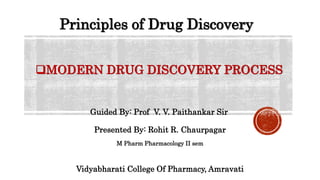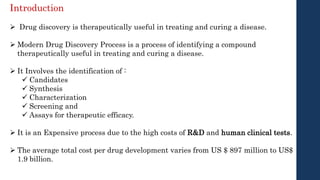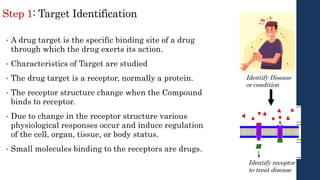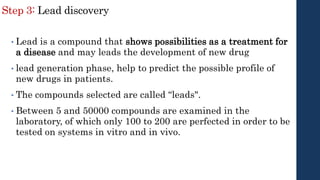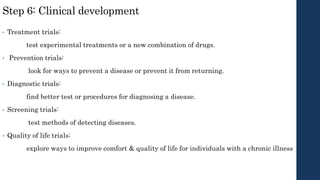Modern drug discovery process|| M pharm Pharmacology.pptx
- 1. MODERN DRUG DISCOVERY PROCESS Presented By: Rohit R. Chaurpagar Principles of Drug Discovery Guided By: Prof V. V. Paithankar Sir Vidyabharati College Of Pharmacy, Amravati M Pharm Pharmacology II sem
- 2. PYQ Que. Explain the stages involved in modern drug discovery process. (summer 2019) 15 Marks
- 3. Drug discovery is therapeutically useful in treating and curing a disease. Modern Drug Discovery Process is a process of identifying a compound therapeutically useful in treating and curing a disease. It Involves the identification of : Candidates Synthesis Characterization Screening and Assays for therapeutic efficacy. It is an Expensive process due to the high costs of R&D and human clinical tests. The average total cost per drug development varies from US $ 897 million to US$ 1.9 billion. Introduction
- 4. Steps in Modern Drug Discovery
- 5. Step 1: Target Identification • A drug target is the specific binding site of a drug through which the drug exerts its action. • Characteristics of Target are studied • The drug target is a receptor, normally a protein. • The receptor structure change when the Compound binds to receptor. • Due to change in the receptor structure various physiological responses occur and induce regulation of the cell, organ, tissue, or body status. • Small molecules binding to the receptors are drugs. Identify Disease or condition Identify receptor to treat disease
- 6. Step 2: Target validation • Target validation is a process by which the predicted molecular target ( protein or nucleic acid) is verified • it prove that manipulating the molecular target can provide therapeutic benefit for patients. • Target validation process might include following steps: Discovering a receptor of interest. Valuating its potential as a target Designing a bioassay to measure biological activity. Constructing a high-throughput screen. Performing screening to find hits. Evaluating the hits • Biochemical classes of drug target G-Protein coupled receptors -45% Enzymes -28% Hormones and factors -11% Ion channels -5% Nuclear receptors -2%
- 7. Step 3: Lead discovery • Lead is a compound that shows possibilities as a treatment for a disease and may leads the development of new drug • lead generation phase, help to predict the possible profile of new drugs in patients. • The compounds selected are called “leads". • Between 5 and 50000 compounds are examined in the laboratory, of which only 100 to 200 are perfected in order to be tested on systems in vitro and in vivo.
- 8. Step 4: Lead optimization • Molecules are chemically modified in order to obtain compounds with suitable properties to become a drug. • Lead optimization is a process that begins with a compound that displays an biological action and ends with the identification of the best analog. • Leads are characterized with respect to pharmacodynamic such as efficacy and potency in vitro and in vivo, Physiochemical properties, pharmacokinetic properties, and toxicological aspects. • Potency - refers to the amount of drug required for its specific effect to occur. • Efficacy - measures the maximum strength of the effect itself, at saturating drug concentrations. • Pharmacokinetics - It explains about "What the body does to the drug". It often divided into areas examining the extent and rate of adsorption, distribution, metabolism, and excretion (ADME). • Pharmacodynamic - It determines the biochemical and physiological effects of drugs, the mechanism of drug action and the relationship between drug concentration and effect. It explains about "What the drug does to the body".
- 9. Step 5: Pre-clinical development • The pre-clinical development includes the following: develop large scale synthesis animal safety studies carcinogenicity tests drug delivery elimination and metabolism studies drug formulation experiments dose-ranging studies in animals. Wide ranging dosages of the compounds are introduced to the cell line or animal in order to obtain preliminary efficacy and pharmacokinetic information.
- 10. Step 6: Clinical development • Treatment trials: test experimental treatments or a new combination of drugs. • Prevention trials: look for ways to prevent a disease or prevent it from returning. • Diagnostic trials: find better test or procedures for diagnosing a disease. • Screening trials: test methods of detecting diseases. • Quality of life trials: explore ways to improve comfort & quality of life for individuals with a chronic illness
- 11. Reference: • Principles of Drug Discovery by Padmaja kore first edition • Chapter 41- Modern drug discovery and Development Science Direct Article
- 12. THAN K YOU

